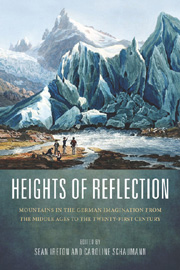 Heights of Reflection
Heights of Reflection Book contents
- Frontmatter
- Contents
- Acknowledgments
- Introduction: The Meaning of Mountains: Geology, History, Culture
- Prelude: Classical Mountain Landscapes and the Language of Ascent
- Part I First Forays: Mountain Exploration and Celebration from the Middle Ages to the Eighteenth Century
- Part II Beckoning Heights: Summits Near and Far in the Nineteenth Century
- Fascinating Voids: Alexander von Humboldt and the Myth of Chimborazo
- From Eros to Thanatos: Hiking and Spelunking in Ludwig Tieck's Der Runenberg
- Geology, Mountaineering, and Self-Formation in Adalbert Stifter's Der Nachsommer
- “An Apparition from Another World”: The Mountains of the Moon and Kilimanjaro from the Perspective of Nineteenth-Century Germany
- Part III Modern Expeditions and Evocations: Climbing from the Twentieth into the Twenty-First Century
- Works Cited
- Notes on the Contributors
- Index
Geology, Mountaineering, and Self-Formation in Adalbert Stifter's Der Nachsommer
from Part II - Beckoning Heights: Summits Near and Far in the Nineteenth Century
Published online by Cambridge University Press: 05 February 2013
- Frontmatter
- Contents
- Acknowledgments
- Introduction: The Meaning of Mountains: Geology, History, Culture
- Prelude: Classical Mountain Landscapes and the Language of Ascent
- Part I First Forays: Mountain Exploration and Celebration from the Middle Ages to the Eighteenth Century
- Part II Beckoning Heights: Summits Near and Far in the Nineteenth Century
- Fascinating Voids: Alexander von Humboldt and the Myth of Chimborazo
- From Eros to Thanatos: Hiking and Spelunking in Ludwig Tieck's Der Runenberg
- Geology, Mountaineering, and Self-Formation in Adalbert Stifter's Der Nachsommer
- “An Apparition from Another World”: The Mountains of the Moon and Kilimanjaro from the Perspective of Nineteenth-Century Germany
- Part III Modern Expeditions and Evocations: Climbing from the Twentieth into the Twenty-First Century
- Works Cited
- Notes on the Contributors
- Index
Summary
Adalbert Stifter's colossal three-volume novel Der Nachsommer (Indian Summer) appeared in 1857 at the apogee of Alpinism's Golden Age, a period of intense summit pursuits that began around 1850 and culminated in 1865 with the first ascent of the Matterhorn. In a unique and oblique way, the novel provides literary testimony to numerous facets of mountaineering history. Throughout the text, Alpine peaks present physical challenges, inspire feelings of awe, and form the principal object of scientific inquiry. Although often categorized as a Bildungsroman (novel of education or self-formation), this book might just as well bear Hermann Broch's label of a Bergroman (mountain novel), for mountains constitute the matrix of its setting, plot, and deeper thematics. Indeed, the idea of Bildung is inextricably linked with the activity of climbing. Moreover, the main character, Heinrich Drendorf, is largely modeled on Stifter's friend Friedrich Simony, a geologist and mountaineer who made exploring the Alps, particularly the Salzkammergut of Austria, his life-long project. Here Simony conducted countless geoscientific studies, many of which are faithfully reproduced in Heinrich's semi-fictionalized sojourns. Heinrich thus proves to be an atypical protagonist within the tradition of the German Bildungsroman. His development is predicated less on artistic aspirations and human relationships than on his interaction with mountains as age-old geophysical formations — or Bildungen. With Der Nachsommer Stifter thus creates a new and literal brand of Bildungsroman, one that is rooted in the discourse and practice of mountaineering during the nineteenth century.
- Type
- Chapter
- Information
- Heights of ReflectionMountains in the German Imagination from the Middle Ages to the Twenty-First Century, pp. 193 - 209Publisher: Boydell & BrewerPrint publication year: 2012


